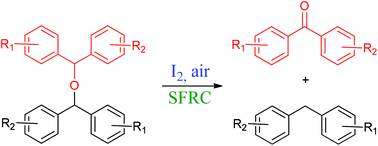Iodine-catalyzed disproportionation of aryl-substituted ethers under solvent-free reaction conditions†
Abstract
Iodine was demonstrated to be an efficient

* Corresponding authors
a
Faculty of Chemistry and Chemical Technology, University of Ljubljana, Aškerčeva 5, PO Box 537, 1001 Ljubljana, Slovenia
E-mail:
marjan.jereb@fkkt.uni-lj.si
Fax: +386 241 9220
Tel: +386 124 19248
b ‘Jožef Stefan’ Institute, Jamova 39, 1000 Ljubljana, Slovenia
Iodine was demonstrated to be an efficient

 Please wait while we load your content...
Something went wrong. Try again?
Please wait while we load your content...
Something went wrong. Try again?
M. Jereb and D. Vražič, Org. Biomol. Chem., 2013, 11, 1978 DOI: 10.1039/C3OB27267B
To request permission to reproduce material from this article, please go to the Copyright Clearance Center request page.
If you are an author contributing to an RSC publication, you do not need to request permission provided correct acknowledgement is given.
If you are the author of this article, you do not need to request permission to reproduce figures and diagrams provided correct acknowledgement is given. If you want to reproduce the whole article in a third-party publication (excluding your thesis/dissertation for which permission is not required) please go to the Copyright Clearance Center request page.
Read more about how to correctly acknowledge RSC content.
 Fetching data from CrossRef.
Fetching data from CrossRef.
This may take some time to load.
Loading related content
